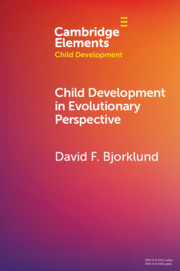Element contents
Child Development in Evolutionary Perspective
Published online by Cambridge University Press: 02 October 2020
Summary
Keywords
- Type
- Element
- Information
- Series: Elements in Child DevelopmentOnline ISBN: 9781108866187Publisher: Cambridge University PressPrint publication: 29 October 2020
References
- 13
- Cited by

